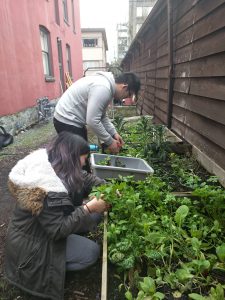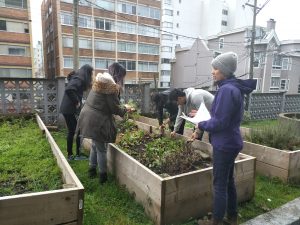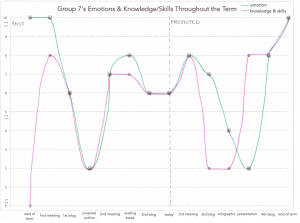Introduction
It’s unbelievable that we’re already heading towards the end of our CBEL project! During the tutorial session, our group had a chance to reflect back and evaluate our overall performance from the beginning of the term to the present. We all agreed that we have done and gained so much more than we initially expected. Crop planning sounds simple at first, but in reality is extremely complex, involving holistic perspectives and aspects that need to be considered. Due to Joey’s gracious guidance and support, we have successfully achieved our goals. After weeks of working on the crop plans, we have begun preparing the plots themselves for the upcoming growing season.
This post will take you through a quick summary of our achievements and experiences since our last post, as well as some thoughts on our remaining time in the project.
Weekly Objectives
Our weekly objectives since the first draft of our second blog post have been:
Feb 25 – Mar 3: Submit our second blog post and receive feedback.
Mar 4 – 10: Have our third meeting with Joey, complete all crop plans and help physically prepare the farm plots. Edit our second blog post and begin writing our third.
Achievements
We began our third meeting by sorting out Joey’s seed box, removing seeds that were too old to sprout and organizing them into vegetable/herb groups. Additionally, we managed to finalize the Jervis location crop plan. This location receives the least amount of sunlight among all of GNH’s plots, so Joey mainly wanted to plant herbs and salad greens here. It seems that these plants grow very well in shaded and cool conditions (J. Liu, personal communication, March 5, 2018). We also visited some of the plots and harvested vegetables and herbs to be used in the GNH kitchen and Farmer’s market, such as salad greens and parsley. The group visited the Crystal Court location and helped prepare the site for the upcoming growing season by removing cover crops, chopping bean leaves and tilling the soil in order to return nitrogen into the soil. We also almost completed the Nicola location crop plan, however, ran out of time and could not visit the site to confirm some final details, so it is the only crop plan that we have left to finalize. We will be meeting with Joey one last time to complete this crop plan. All in all, this was a very productive meeting! It felt really good to finally see the project coming together, and to physically see the plots be prepared for our plans.

Sorting out a bag of seeds

Harvesting leafy greens at Jervis Garden

Removing cover crops at Nicola Garden
Even though we didn’t necessarily meet any concrete failures over the course of our project, our group has faced some huge uncertainties, both involving our academic performance and the project itself. Additionally, Joey has met and resolved many uncertainties and setbacks from her previous urban farming experiences. For example, the reason we were asked to sort and discard the seeds harvested before 2015 was because when Joey had previously tried to plant older seeds, she found that they couldn’t grow well. This caused her to waste time and space that could have been devoted to other crops. Even though we were not doing a “premortem” like what was discussed in the “Failure is Your Friend” podcast, we were able to draw lessons from previous experiences and “spot the potential failures before things have gone wrong” (Cohn, 2014).
At this time, our crop plan is mostly finished, however, we are aware that there will be a lot of uncertainties when the crop plan is actually being executed. Unfortunately, this won’t be a part of our project. The manual that we used to decide what crops to plant, when to sow, etc. is based on general coastal BC weather, but there are many potential variables (e.g. soil condition, humidity, sunlight etc.) that may result in a different growth pattern of crops in our three garden sites. This is similar to Dan Barber’s story in the This American Life podcast, “Poultry Slam” (Glass, 2011), which tells us that it is normally difficult to replicate other people’s operational models in different environmental settings, especially when it comes to dealing with nature which always “has its own idea.” Joey has prior experience with urban farming, so hopefully these variables will not provide many setbacks for this growing season. Since we are planning on having at least one more meeting with her, we can also assess the plots and provide any changes that might be necessary, and hopefully, some of our group members will be able to keep in contact with Joey and the GNH to provide volunteer work over the season.
Moment of Significant Change Workshop
During our session 8 tutorial, we were asked to reflect on our experiences with the CBEL project in the past few months. We were also instructed to individually graph the progression of our knowledge/skills and emotions regarding the project, and then we were asked to construct two comprehensive graphs illustrating these as a group. Overall, we felt that this was a very important workshop, as it allowed us to really reflect on the time we’ve spent working on this project, how much we’ve learned and achieved, and the emotions that we’ve experienced from the start of the term to now. In addition, this was a chance for us to really be able to share our personal experiences regarding the project within our group, and it turned out that there were some similarities and some differences within the group. For example, a couple of us were unable to attend the second meeting with our community partner, Joey, and those individuals felt slightly lost about the project, wishing they were able to contribute more. However, these negative feelings were addressed as we made plans to and actually went to meet Joey a third time. After finalizing the crop plan for the Jervis location and helping out with plot preparations, we’re now feeling more confident about finishing up our project.
In addition to reflecting on the time we’ve spent so far on the project, we also came up with a projected section of the graph that represents how we believe the next couple of weeks will unfold, as well as how we hope to wrap up our project at the end of the term.

Shown above is the group graph plotting our emotions and our knowledge and skills over the course of the term. The smiley face indicates a high positive feeling/sense of knowledge and the sad face indicates a low negative feeling/sense of knowledge. Some key points are described below:
- At the beginning of the term, we were feeling overall quite positive and excited about our GNH Crop Plan project, although most of us were from food science major and were not very knowledgeable about urban agriculture, or what the project would really entail.
- We had a better idea of what was expected of us in this project after our 1st meeting with Joey. However, both curves dropped slightly after writing our 1st blog post and receiving feedback for it because we noticed that we were still confused about some concepts we learned from class (e.g. food justice and community food security).
- Notably, we hit a low point in both curves during our first Moment of Significance, which was when we were working on our Proposal Outline and Report, as this was when we really realized that we had been focusing on the wrong area, learning that we should have been focused on creating a suitable crop plan to increase community food security, rather than trying to integrate too many components from our course materials and making the scope of our project too broad and unfocused.
- For those of us that attended the 2nd meeting with Joey, a lot more knowledge was gained and there was an overall positive feeling about the project, as we managed to come up with the plan for Crystal Court, which was the most challenging garden to plan.
- Our overall feelings soared over reading break, as we were all excited for this time to be away from school, although our knowledge and skills stayed stagnant as we didn’t meet with Joey or do too much work on the project.
- Then, from writing our 2nd blog post up until today, both graphs sat at a slightly lower level to reflect our slight dread at writing blog posts as well as our uncertainty about whether we approached our Moment of Significance properly.
In the projected section of our graph, we expected our 3rd meeting with Joey to go very well (and it did!), and we expected to feel a bit clueless about writing this current blog. However, after receiving feedback from our 2nd blog, we are a bit more confident about what is expected from us. We may feel a bit reluctant about creating our infographics and expect that we’ll feel pretty in the dark prior to the workshop. We’re all a bit nervous about the presentation that is coming up, but we’re hoping that by that point, we will be very knowledgeable about our project! We’re also feeling pretty positive overall about our 4th and last blog post, and definitely expect to finish this term off on a high note.
Upcoming Objectives
During our past visit at the GNH this Monday, we were able to complete our most of the remaining two crop plans, which essentially means that we have finished our entire CBEL project. We still plan on visiting the GNH at least one more time to assist Joey in harvesting and preparing the plots for seeding, but that will be it for our actual Community Project. The end of the term seems to be coming very quickly, and we are sad to see it finish so soon!
As for the course, we are entering the final stage of the term, which means that we need to start thinking about working on our final report, presentation and infographic as a group, and individually work on our Academic and Experiential Review papers.
Mar 11 – 17: Anticipating another meeting with Joey to prepare the Nicola site. Will edit our third blog post after receiving feedback.
Mar 18 -24: Work on our final presentation and infographic.
Mar 25 – 31: Present our community project and write our last blog post for the semester.
Graceful Dismount
With the completion of our Community Project and the end of the school year, it is time for our group to begin our “Graceful Dismount.” We must take what we have learned in our readings, lectures, and tutorials, and reflect on the work that we have done at the Gordon Neighbourhood House. Completing our Community Project was an eye-opening experience that was very valuable in showing us how much time and energy is put into supporting communities, and we will be sure to carry these experiences with us as we continue our journeys as citizens and academics in the food system.
In our first flexible learning session (session 3), we watched a couple of videos concerning partnerships and the patronizing and paternalistic nature of Western “aid” (Yakini, 2013), (Sirolli, 2012). We want to ensure that we do not simply enter and exit this project with a saviour complex, simply leaving when our job is done and forgetting about the people that the GNH is serving and the reasons for our work. LFS 350 is set up in a way that will allow us to remain connected with our work even after completing the project, with the final presentation and report allowing us to reflect on it. Furthermore, we are able to use our experiences as a stepping stone for continuing similar work either at GNH, other neighbourhood houses or similar organizations. Working at the GNH has given us a better perspective of what resources organizations are in need of, whether that be time, physical labour, food, etc. Pablo, one of our group members, actually lives in the West End, and has done some volunteer work there prior to our project, and plans on continuing to do so after we complete our project time with them. As for the rest of our group, we can use our newfound experiences and information to better serve our own communities in the future and to increase awareness of the issues that we have been working on.
Conclusion
At this point of time, it is really important to look both backward and forward so that we can reflect on our past activities and experiences to better achieve our future goals. Making the reflective graphs during tutorial was really interesting and insightful, helping us trace the fluctuations in our emotions and knowledge during different events and tasks. Despite these fluctuations and uncertainties, we have successfully completed all of our goals on time so far and met our expectations due to the active support provided by Joey. Even though we are very proud of our achievements thus far, we are still a bit worried about the uncertainties that GNH may be facing following the execution of our crop plans, therefore it is also important for us to keep in touch with Joey and provide assistance during growing and harvesting season when needed. We have a laundry list of assignments and projects about the CBEL project to complete in the next few weeks, so it is time to start buckling down and focusing on these, as well!
References
Cohn, G. (2014, June 5). Failure Is Your Friend: A New Freakonomics Radio Podcast. Retrieved March 9th, 2018 from
http://freakonomics.com/podcast/failure-is-your-friend-a-new-freakonomics-radio-podcast/
Glass, I. (2011, December 2). Poultry Slam 2011. Retrieved March 9th, 2018 from https://www.thisamericanlife.org/452/poultry-slam-2011
Sirolli, E. [TED]. (2012, November 26). Want to help someone? Shut up and listen [Video File]. Retrieved March 9th, 2018 from https://www.youtube.com/watch?v=chXsLtHqfdM
Yakini, M. [LivableFutureBlog]. (2013, May 3). Working in communities as partners, not missionaries [Video File]. Retrieved March 9th, 2018 from https://www.youtube.com/watch?v=qO9_dgcxdj4